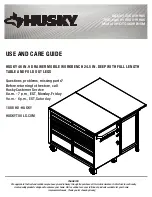
Heat Dissipation
Traditional heat dissipation modes are as follows:
l
Controller enclosure
Cooling air enters from the front end through small holes on the interface modules. After
dissipating the heat of interface modules, controllers, and power modules, the air is
discharged out of its back end by fans. The controller enclosure dynamically adjusts
rotational speed of the fans based on the operational temperature of the storage system.
l
Disk enclosure
Cooling air enters from the front end through the space between disks, passing the
midplane, into the power modules and expansion modules. After dissipating the heat, the
air is discharged out of its back end by fans. The disk enclosure dynamically adjusts
rotational speed of the fans based on the operational temperature of the storage system.
For better maintenance, ventilation, and heat dissipation, pay attention to the following when
installing the storage system in the cabinet:
l
To ensure smooth ventilation, the cabinet should be at least 100 cm (39.4 inches) away
from the equipment room walls and at least 120 cm (47.24 inches) away from other
cabinets (that are in front of or behind).
l
To keep air convection between the cabinet and the equipment room, no enclosed space
is allowed in the cabinet. 1 U (44.45 mm or 1.75 inches) space should be left above and
below each device.
The airflow parameters of the storage system are listed in
.
Table 7-7
Airflow parameters of storage systems
Device
System Airflow
Controller enclosure
l
75 CFM
a
(at max. fan speed)
l
24 CFM (25°C)
2 U disk enclosure
l
117 CFM (at max. fan speed)
l
38 CFM (25°C)
4 U disk enclosure
l
151 CFM (at max. fan speed)
l
52 CFM (25°C)
4 U high-density disk enclosure
l
210 CFM (maximum fan speed)
l
116 CFM (25°C)
a: CFM, Cubic Feet per Minute
The heat dissipation parameters of the storage system are listed in
.
OceanStor 2600 V3
Product Description
7 Environmental Requirements
Issue 09 (2019-05-15)
Copyright © Huawei Technologies Co., Ltd.
141
















































